小升初复习专题——数词专项课件(共36张PPT)
文档属性
| 名称 | 小升初复习专题——数词专项课件(共36张PPT) | 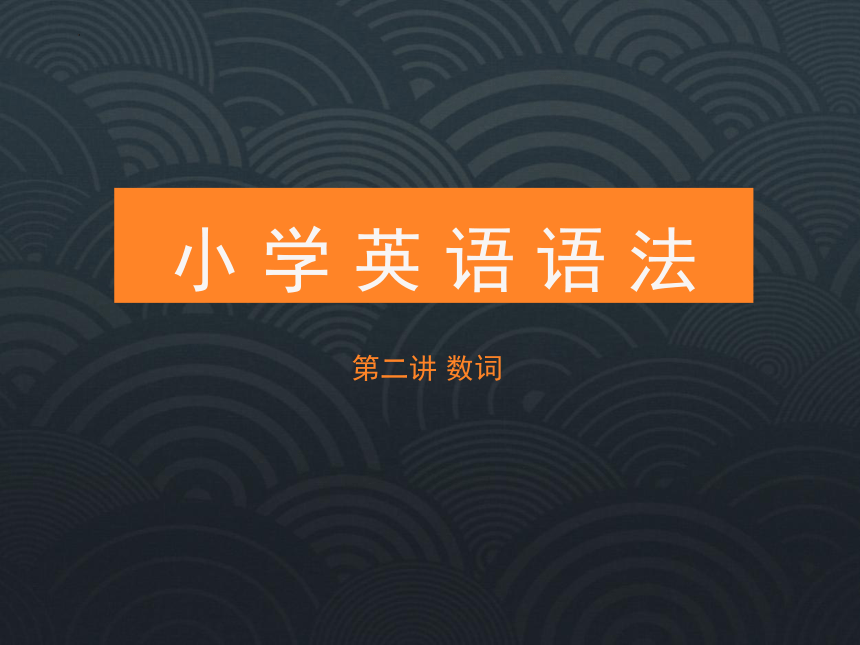 | |
| 格式 | pptx | ||
| 文件大小 | 3.2MB | ||
| 资源类型 | 教案 | ||
| 版本资源 | 通用版 | ||
| 科目 | 英语 | ||
| 更新时间 | 2022-05-03 19:41:20 | ||
图片预览

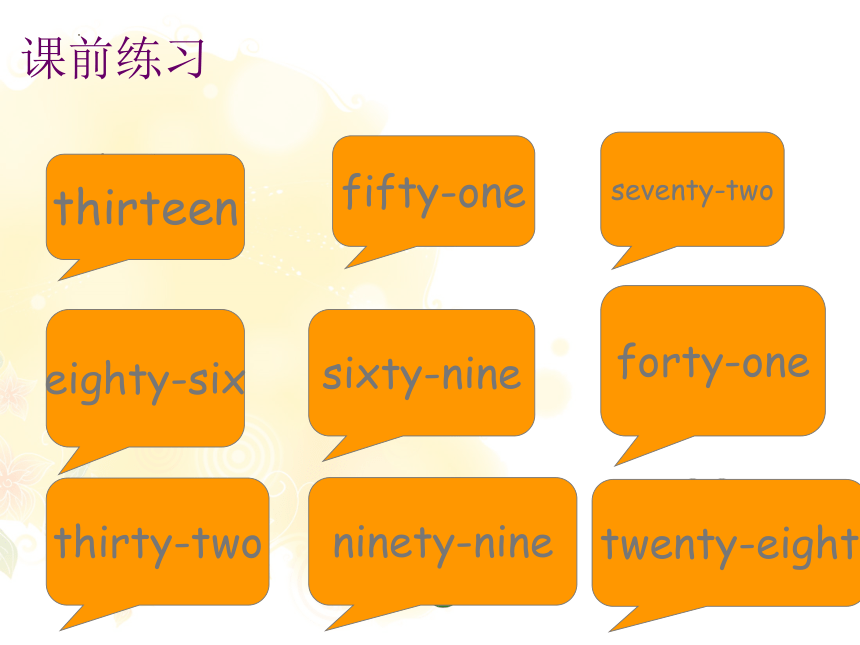

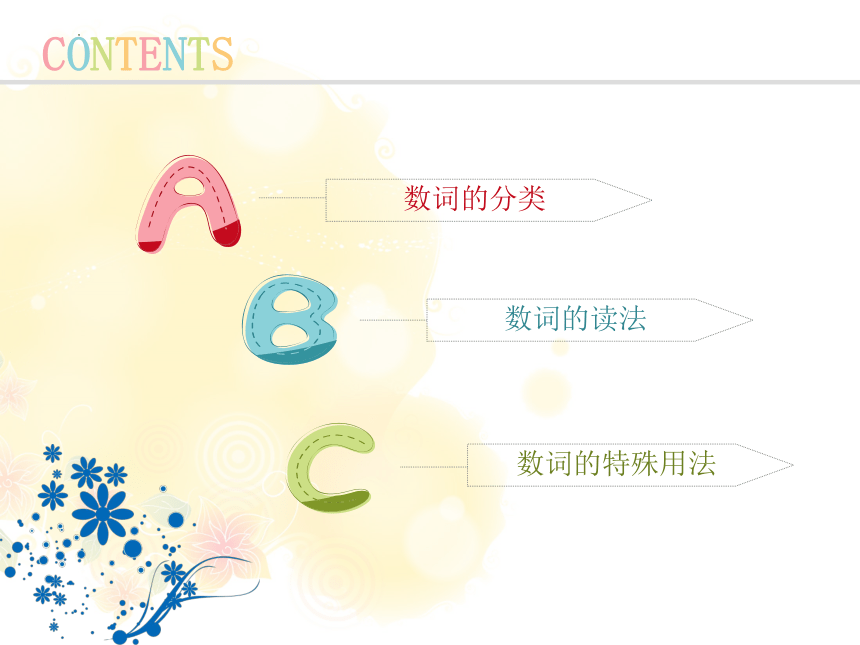
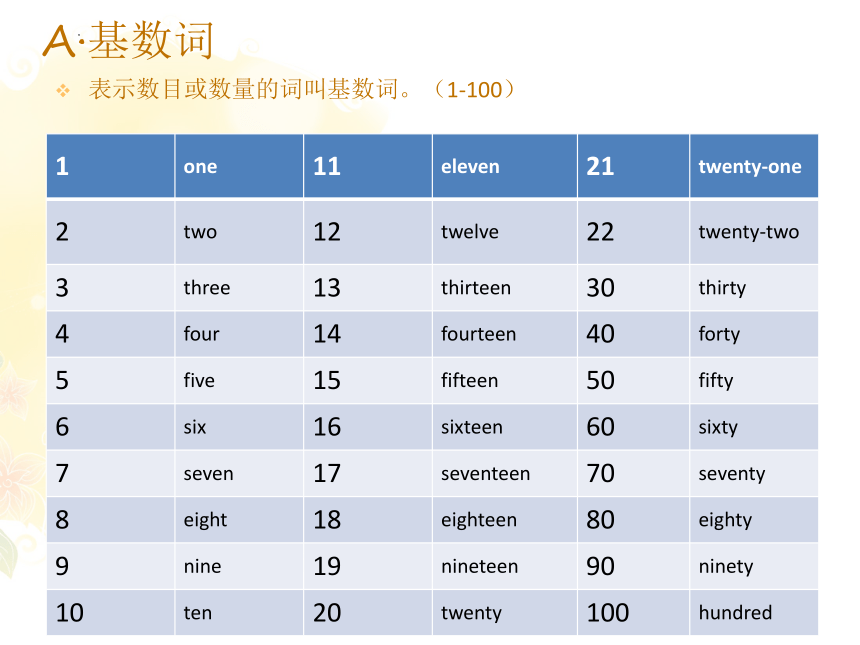
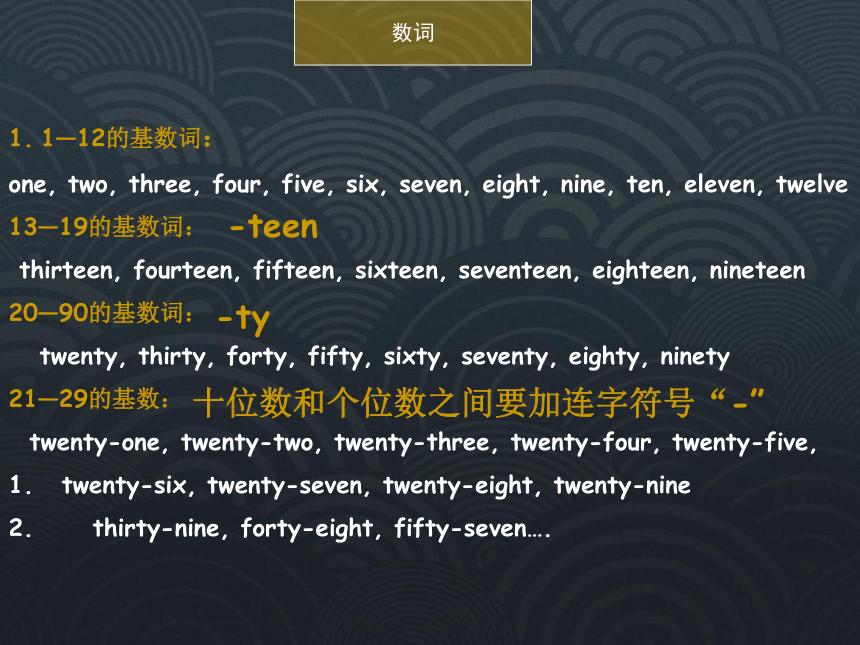
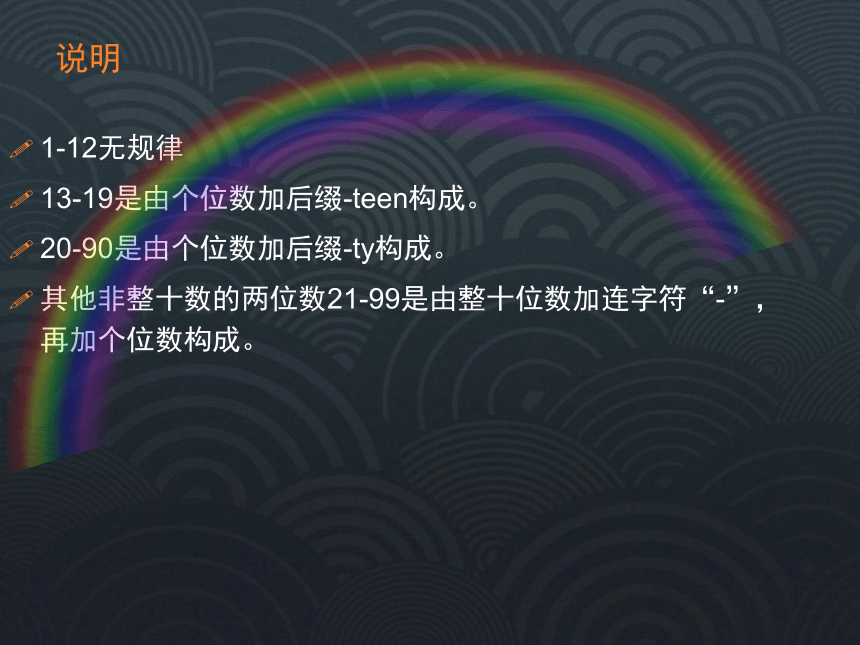

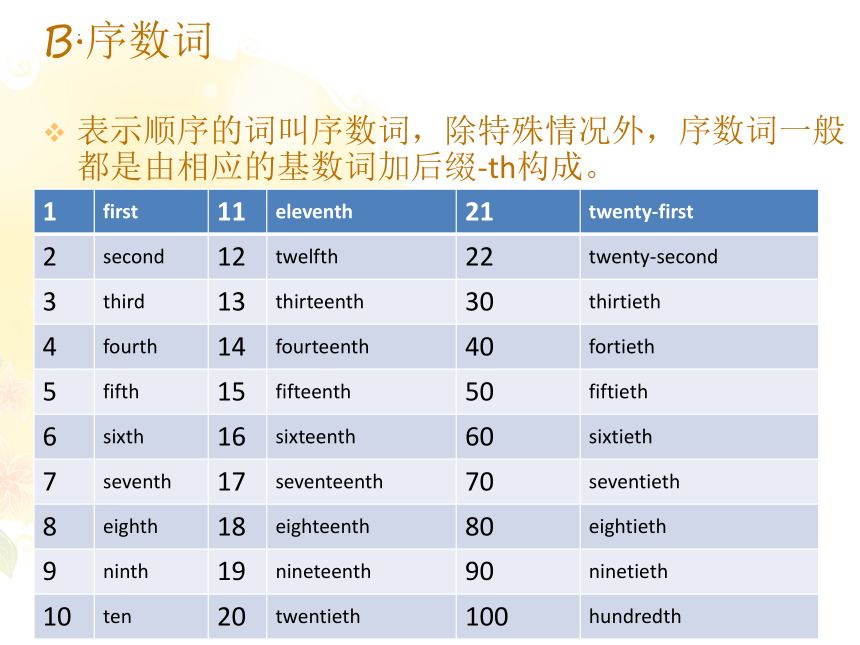
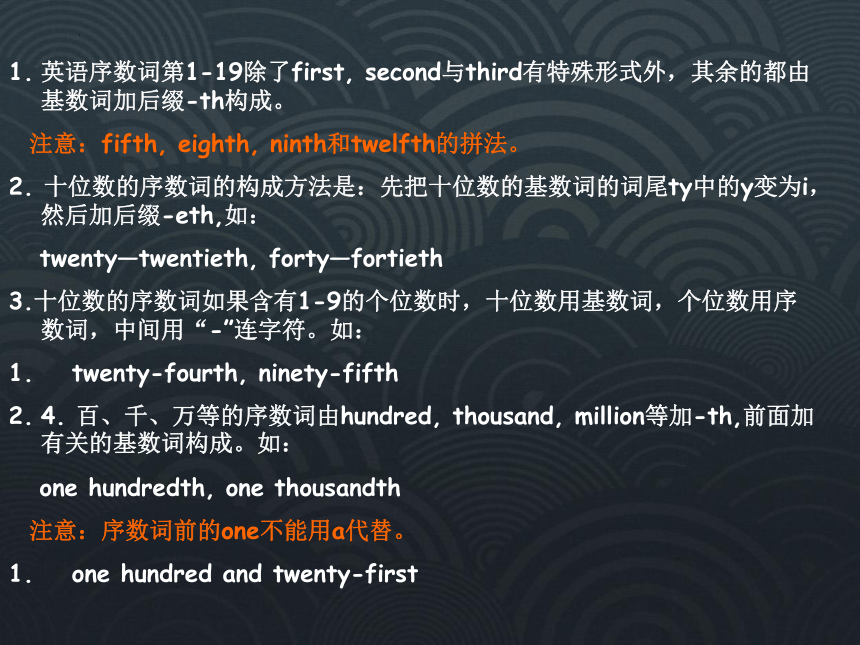
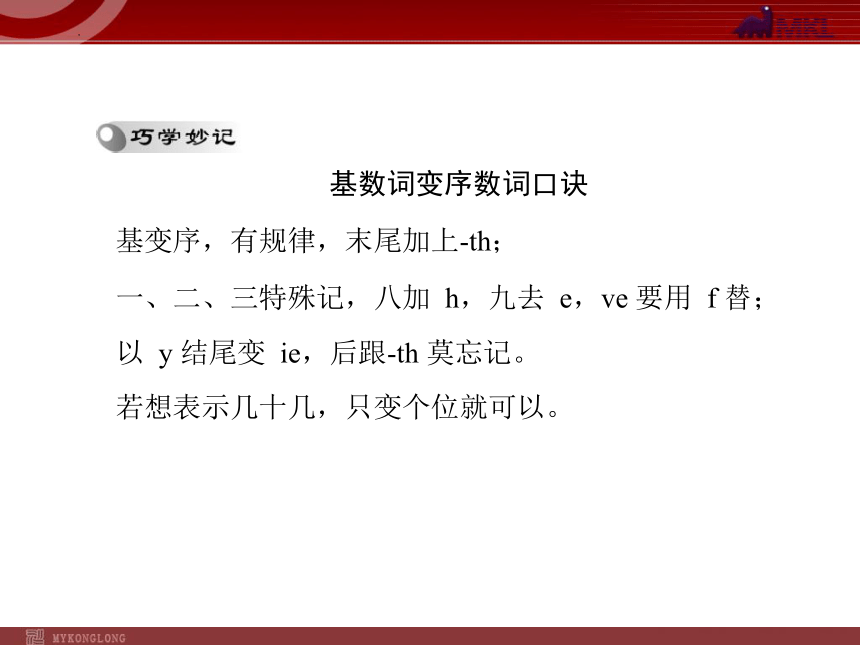
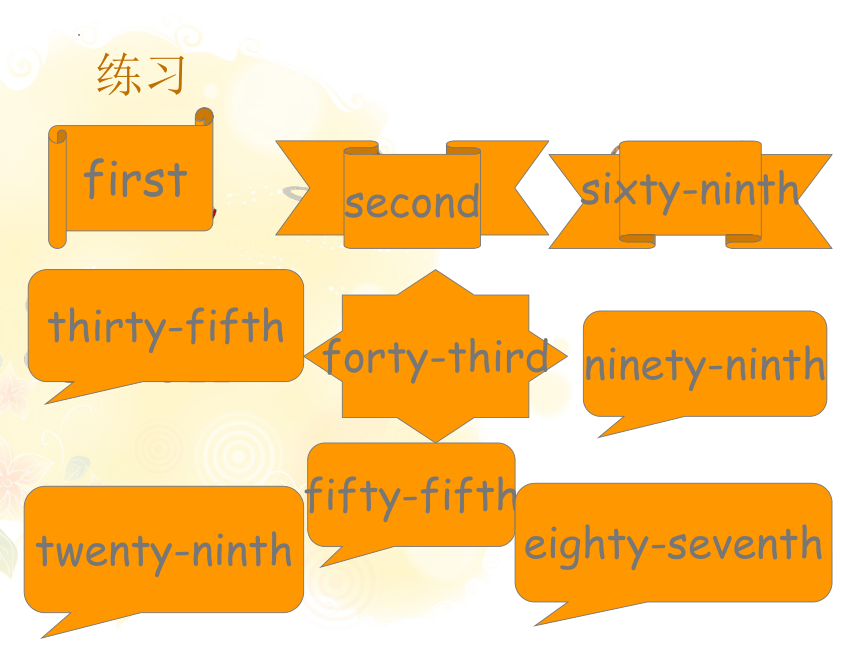
文档简介
(共36张PPT)
小 学 英 语 语 法
第二讲 数词
课前练习
13
51
72
86
69
32
41
99
28
thirteen
fifty-one
seventy-two
eighty-six
sixty-nine
forty-one
thirty-two
ninety-nine
twenty-eight
数词的定义
表示“多少”和“第几”的词,叫数词。
其用法相当于名词或者形容词。
CONTENTS
数词的分类
数词的读法
数词的特殊用法
A·基数词
表示数目或数量的词叫基数词。(1-100)
1 one 11 eleven 21 twenty-one
2 two 12 twelve 22 twenty-two
3 three 13 thirteen 30 thirty
4 four 14 fourteen 40 forty
5 five 15 fifteen 50 fifty
6 six 16 sixteen 60 sixty
7 seven 17 seventeen 70 seventy
8 eight 18 eighteen 80 eighty
9 nine 19 nineteen 90 ninety
10 ten 20 twenty 100 hundred
数词
1—12的基数词:
one, two, three, four, five, six, seven, eight, nine, ten, eleven, twelve
13—19的基数词:
thirteen, fourteen, fifteen, sixteen, seventeen, eighteen, nineteen
20—90的基数词:
twenty, thirty, forty, fifty, sixty, seventy, eighty, ninety
21—29的基数:
twenty-one, twenty-two, twenty-three, twenty-four, twenty-five,
twenty-six, twenty-seven, twenty-eight, twenty-nine
thirty-nine, forty-eight, fifty-seven….
-teen
-ty
十位数和个位数之间要加连字符号“-”
说明
1-12无规律
13-19是由个位数加后缀-teen构成。
20-90是由个位数加后缀-ty构成。
其他非整十数的两位数21-99是由整十位数加连字符“-”,再加个位数构成。
2. 百位数:
one hundred, two hundred, three hundred, four hundred…
five hundred and eight-six, six hundred and ninety-nine,
seven hundred and eight, eight hundred and one
3. 千位数:
one thousand, four thousand, seven thousand one hundred and five
百位数和十位数之间加and。
注意
英语中没有“万”这个单位,所以常用thousand来表示。
ten thousand, thirty thousand, fifteen thousand one hundred,
five hundred and one thousand four hundred and thirty-two
知 识 拓 展
B·序数词
表示顺序的词叫序数词,除特殊情况外,序数词一般都是由相应的基数词加后缀-th构成。
1 first 11 eleventh 21 twenty-first
2 second 12 twelfth 22 twenty-second
3 third 13 thirteenth 30 thirtieth
4 fourth 14 fourteenth 40 fortieth
5 fifth 15 fifteenth 50 fiftieth
6 sixth 16 sixteenth 60 sixtieth
7 seventh 17 seventeenth 70 seventieth
8 eighth 18 eighteenth 80 eightieth
9 ninth 19 nineteenth 90 ninetieth
10 ten 20 twentieth 100 hundredth
英语序数词第1-19除了first, second与third有特殊形式外,其余的都由基数词加后缀-th构成。
注意:fifth, eighth, ninth和twelfth的拼法。
2. 十位数的序数词的构成方法是:先把十位数的基数词的词尾ty中的y变为i,然后加后缀-eth,如:
twenty—twentieth, forty—fortieth
3.十位数的序数词如果含有1-9的个位数时,十位数用基数词,个位数用序数词,中间用“-”连字符。如:
twenty-fourth, ninety-fifth
4. 百、千、万等的序数词由hundred, thousand, million等加-th,前面加有关的基数词构成。如:
one hundredth, one thousandth
注意:序数词前的one不能用a代替。
one hundred and twenty-first
基数词变序数词口诀
基变序,有规律,末尾加上-th;
一、二、三特殊记,八加 h,九去 e,ve 要用 f 替;
以 y 结尾变 ie,后跟-th 莫忘记。
若想表示几十几,只变个位就可以。
练习
1st
2nd
68th
35th
43rd
29th
99th
55th
87th
first
second
sixty-ninth
thirty-fifth
forty-third
ninety-ninth
twenty-ninth
fifty-fifth
eighty-seventh
数 词 的 用 法
基数词的用法
1.基数词在句中可作主语、宾语、表语、定语和同位语。
如:
Two of the books are about American history.
这些书中有两本是有关美国历史的。(作主语)
We need three altogether.
我们总共需要三个。(作宾语)
I'm eighteen.我 18 岁。(作表语)
Ten people will come to the party.
十个人要来参加聚会。(作定语)
We four will go for a picnic.
我们四个将去野餐。(作同位语)
2.大于 1 的基数词表示数量时,后面用名词复数形式。如:
I have two sisters.我有两个妹妹。
I'd like three pieces of bread.我想要三片面包。
注意:表示时间、距离、金钱的数字或名词短语作主语表
达一个整体概念时,谓语动词用单数。如:
Three years is too short for her.
三年时间对她来说太短暂了。
One million dollars is a lot of money.
一百万美元是一笔巨款。
3.基数词也可以用来编号,即“名词+基数词=the+序
数词+名词”。要注意字母的大小写和单词的顺序。如:
Book 3/Book Three 第三册书
Lesson One=the first lesson 第一课
Class 3 Grade 6 六年级三班
Room 602 602 房间
Bus No.2/the No.2 bus 2 路公共汽车
No.103 Middle School 第 103 中学
4.hundred, thousand, million, billion 的用法。
(1)hundred, thousand, million, billion 等表示具体数目时,其
自身用单数形式,不加-s。如:
five hundred students 五百名学生
(2)表示大概(不确定)数目时,要在它们的词尾加-s,且要与
of 连用。如:
thousands of 数以千计的,成千上万的
millions of 数以百万计的,数百万的
注意:此种结构前面可以用 many, several, a few 修饰。如:
many hundreds of birds 数以百计的小鸟
5.“基数词+单位名词+形容词”可用来描述事物的形态
特征,且单位名词的单复数根据基数词而定。此结构常作表语。
如:
It's 100 metres deep/long/wide/tall (high).
它有 100 米深/长/宽/高。
也可以用“基数词+单位名词+名词/形容词”构成合成
形容词,每个词之间用连字符“-”连接。此结构中的单位名词
和名词均不能用复数,也不能用所有格形式。此结构常作定语。
如:
a two-hundred-day adventure trip
两百天的冒险旅程
a ten-minute walk=ten minutes' walk
十分钟的路程
a sixteen-year-old boy
一个 16 岁的男孩
6.表示时间。
(1)“整点”的表达:基数词+o'clock (可省略)。如:
seven (o'clock) 7:00
(2)“几点几分”的表达:
①顺读法:直接用基数词表示,即“钟点数+分钟数”。
如:
two fifty-five 2:55
nine twenty 9:20
②逆读法:当分钟数小于或等于 30 时,用介词 past,即“分
钟数+past+钟点数”。如:
ten past ten 10:10
thirty past eight
8:30
当分钟数大于 30 时,用介词 to,即“(60-分钟数)+to+(钟
点数+1)”,表示“差几分几点”。如:
ten to nine 8:50
twenty to three 2:40
注意:
(1)表示几刻钟常用“quarter”。如:
a quarter past two 2:15
fifteen to eight/a quarter to eight 7:45
(2)表示半小时常用“half”。如:
half an hour 半小时
half past six 6:30
one and a half hours/one hour and a half 一个半小时
7.表示日期。
表示年、月、日时,年用基数词,日用序数词,并常在年
前加逗号。只表示年和月时中间可不用逗号。在英语中,年、
月、日的排列顺序为“月、日、年”(美式)或“日、月、年”(英
式)。如:
15th, August, 2012 (英)/August 15th, 2012 (美)
2012 年 8 月 15 日
in December 2010 在 2010 年 12 月
on the 8th of August, 2008 在 2008 年 8 月 8 日
注意:
(1)在年月日的书写中,表示几号的序数词前不写 the,但在
读法中要把 the 读出来。如:
15th, August, 2012 读作:the fifteenth, August, two thousand
and twelve
(2)年的读法:
1998 读作:nineteen ninety-eight
1806 读作:eighteen and six
2007 读作:two thousand and seven 或 twenty zero seven
8.表示年代。如:
in the 1980's/1980s 在 20 世纪 80 年代
9.表示年龄。
(1)基数词(+years old)。如:
He is eleven (years old) now.他现在 11 岁。
(2)at the age of+基数词。如:
At the age of ten he came to Zhongshan.
他 10 岁的时候来到中山。
(3)“基数词+year/month/day+old”构成合成形容词,中
间用连字符连接,表示“……岁/月/天的”。如:
a three-month-old baby 一个三个月大的婴儿
(4)“in+one's+整十基数词复数”表示“在某人几十多岁
时”。如:
in his thirties 在他 30 多岁时
10.表示加、减、乘、除等运算。如:
Eight minus five is three.八减五等于三。
Two times three is six.二乘三等于六。
11.表示次数、倍数。“一次”是 once, “两次”习惯上用
twice, 其他的用“基数词+times”表示。如:
four times 四次/四倍
ten times 十次/十倍
This tree is three times as tall as that one.
这棵树是那棵树的三倍高。
12.表示非整数。
(1)分数的表达法:分子用基数词,分母用序数词。分子大
于 1 时,分母要加-s。如:
one second 或 a/one half 二分之一
two thirds 三分之二
one fourth/a quarter 四分之一
three fourths/three quarters 四分之三
(2)小数的表达法:小数点用“point”。如:
three point six 3.6
(zero) point four 0.4
(3)百分数的表达法:“百分之……”用“percent”。如:
fifty percent 50%
注意:分数、小数、百分数在修饰名词时常用 of 和名词连
接,此时谓语动词的单复数由后面的名词决定。如:
Four fifths of the work is finished.
完成了五分之四的工作。
Twenty percent of the students are out of school.
百分之二十的学生辍学了。
序数词的用法
1.序数词在句中可作主语、宾语、定语和表语。如:
The second is what I really need.
第二个是我真正需要的。(作主语)
He chose the second.
他选了第二个。(作宾语)
We are to carry out the first plan.
我们将执行第一个计划。(作定语)
2.序数词前面一般要加定冠词 the,后面一般用单数名词。
如:
He lives on the second floor.他住在二楼。
注意:
(1)当序数词前有形容词性物主代词或名词所有格时,就不
用 the;当序数词作状语时不用 the。如:
He's my first friend.他是我的第一个朋友。
She always gets to school first.
她总是第一个到学校。
(2)序数词与名词构成的复合名词前不用 the。如:
a second-hand bookstore 一家二手书店
(3)一些习惯用语中的序数词前也不用 the。如:
at first 首先,起初
first of all 第一,首先
at first sight 乍一看到,第一眼
from first to last 自始至终
40
minutes'
walk
一、完成句子,每空一词
1.It's _____ ________ ________ (40 分钟的步行路程) from
our school to the park.
two
or
three
times
2 . Most students watch TV________ ________ ________
________ (两到三次) a week.
the
twelfth
lesson
3.Today we are going to learn________ ________ ________
(第十二课).
in
his
twenties
4.He got married ________ ________ ________ (在他二十
多岁时).
Thousands
of
people
5. ___________ _____ ________ (数以千计的人) crowded
into the beach.
去掉 the
twentyth→twentieth
二、单句改错
1.It is my the first bag.__________
2.Can you show me the twentyth book?________________
3 . There
are
three
hundreds
trees
behind
the
playground.__________________
hundreds→hundred
(
)1.(开心做题)—How was your weekend
—Great! It was my grandfather's ________ birthday.We
enjoyed ourselves.
A.seventy
C.the seventieth
B.seventieth
D.Seventeenth
B
题意:“你的周末过得怎么样?”“很棒!我爷爷
过 70 岁的生日,我们玩得很开心。”表示某人的第几个生日要
用序数词,且因为前面有名词所有格修饰,所以不加 the。
(
)2.(开心做题)Three students ran faster than Lily
in the race.Lily was ________.
A.the fourth
B.four
C.the third
A 题意:在比赛中,三个学生比 Lily 跑得快,Lily 是第
四名。表示“第几”用序数词,故选 A。
(
)3.(开心做题) There are nine ________
students in our school.
A. hundreds
B.hundreds of
C.hundred
C hundred 前面有具体数字时不加-s,无具体数字时常用
hundreds of (成百上千的)。故选 C。
拓 展 题
Thank you!
小 学 英 语 语 法
第二讲 数词
课前练习
13
51
72
86
69
32
41
99
28
thirteen
fifty-one
seventy-two
eighty-six
sixty-nine
forty-one
thirty-two
ninety-nine
twenty-eight
数词的定义
表示“多少”和“第几”的词,叫数词。
其用法相当于名词或者形容词。
CONTENTS
数词的分类
数词的读法
数词的特殊用法
A·基数词
表示数目或数量的词叫基数词。(1-100)
1 one 11 eleven 21 twenty-one
2 two 12 twelve 22 twenty-two
3 three 13 thirteen 30 thirty
4 four 14 fourteen 40 forty
5 five 15 fifteen 50 fifty
6 six 16 sixteen 60 sixty
7 seven 17 seventeen 70 seventy
8 eight 18 eighteen 80 eighty
9 nine 19 nineteen 90 ninety
10 ten 20 twenty 100 hundred
数词
1—12的基数词:
one, two, three, four, five, six, seven, eight, nine, ten, eleven, twelve
13—19的基数词:
thirteen, fourteen, fifteen, sixteen, seventeen, eighteen, nineteen
20—90的基数词:
twenty, thirty, forty, fifty, sixty, seventy, eighty, ninety
21—29的基数:
twenty-one, twenty-two, twenty-three, twenty-four, twenty-five,
twenty-six, twenty-seven, twenty-eight, twenty-nine
thirty-nine, forty-eight, fifty-seven….
-teen
-ty
十位数和个位数之间要加连字符号“-”
说明
1-12无规律
13-19是由个位数加后缀-teen构成。
20-90是由个位数加后缀-ty构成。
其他非整十数的两位数21-99是由整十位数加连字符“-”,再加个位数构成。
2. 百位数:
one hundred, two hundred, three hundred, four hundred…
five hundred and eight-six, six hundred and ninety-nine,
seven hundred and eight, eight hundred and one
3. 千位数:
one thousand, four thousand, seven thousand one hundred and five
百位数和十位数之间加and。
注意
英语中没有“万”这个单位,所以常用thousand来表示。
ten thousand, thirty thousand, fifteen thousand one hundred,
five hundred and one thousand four hundred and thirty-two
知 识 拓 展
B·序数词
表示顺序的词叫序数词,除特殊情况外,序数词一般都是由相应的基数词加后缀-th构成。
1 first 11 eleventh 21 twenty-first
2 second 12 twelfth 22 twenty-second
3 third 13 thirteenth 30 thirtieth
4 fourth 14 fourteenth 40 fortieth
5 fifth 15 fifteenth 50 fiftieth
6 sixth 16 sixteenth 60 sixtieth
7 seventh 17 seventeenth 70 seventieth
8 eighth 18 eighteenth 80 eightieth
9 ninth 19 nineteenth 90 ninetieth
10 ten 20 twentieth 100 hundredth
英语序数词第1-19除了first, second与third有特殊形式外,其余的都由基数词加后缀-th构成。
注意:fifth, eighth, ninth和twelfth的拼法。
2. 十位数的序数词的构成方法是:先把十位数的基数词的词尾ty中的y变为i,然后加后缀-eth,如:
twenty—twentieth, forty—fortieth
3.十位数的序数词如果含有1-9的个位数时,十位数用基数词,个位数用序数词,中间用“-”连字符。如:
twenty-fourth, ninety-fifth
4. 百、千、万等的序数词由hundred, thousand, million等加-th,前面加有关的基数词构成。如:
one hundredth, one thousandth
注意:序数词前的one不能用a代替。
one hundred and twenty-first
基数词变序数词口诀
基变序,有规律,末尾加上-th;
一、二、三特殊记,八加 h,九去 e,ve 要用 f 替;
以 y 结尾变 ie,后跟-th 莫忘记。
若想表示几十几,只变个位就可以。
练习
1st
2nd
68th
35th
43rd
29th
99th
55th
87th
first
second
sixty-ninth
thirty-fifth
forty-third
ninety-ninth
twenty-ninth
fifty-fifth
eighty-seventh
数 词 的 用 法
基数词的用法
1.基数词在句中可作主语、宾语、表语、定语和同位语。
如:
Two of the books are about American history.
这些书中有两本是有关美国历史的。(作主语)
We need three altogether.
我们总共需要三个。(作宾语)
I'm eighteen.我 18 岁。(作表语)
Ten people will come to the party.
十个人要来参加聚会。(作定语)
We four will go for a picnic.
我们四个将去野餐。(作同位语)
2.大于 1 的基数词表示数量时,后面用名词复数形式。如:
I have two sisters.我有两个妹妹。
I'd like three pieces of bread.我想要三片面包。
注意:表示时间、距离、金钱的数字或名词短语作主语表
达一个整体概念时,谓语动词用单数。如:
Three years is too short for her.
三年时间对她来说太短暂了。
One million dollars is a lot of money.
一百万美元是一笔巨款。
3.基数词也可以用来编号,即“名词+基数词=the+序
数词+名词”。要注意字母的大小写和单词的顺序。如:
Book 3/Book Three 第三册书
Lesson One=the first lesson 第一课
Class 3 Grade 6 六年级三班
Room 602 602 房间
Bus No.2/the No.2 bus 2 路公共汽车
No.103 Middle School 第 103 中学
4.hundred, thousand, million, billion 的用法。
(1)hundred, thousand, million, billion 等表示具体数目时,其
自身用单数形式,不加-s。如:
five hundred students 五百名学生
(2)表示大概(不确定)数目时,要在它们的词尾加-s,且要与
of 连用。如:
thousands of 数以千计的,成千上万的
millions of 数以百万计的,数百万的
注意:此种结构前面可以用 many, several, a few 修饰。如:
many hundreds of birds 数以百计的小鸟
5.“基数词+单位名词+形容词”可用来描述事物的形态
特征,且单位名词的单复数根据基数词而定。此结构常作表语。
如:
It's 100 metres deep/long/wide/tall (high).
它有 100 米深/长/宽/高。
也可以用“基数词+单位名词+名词/形容词”构成合成
形容词,每个词之间用连字符“-”连接。此结构中的单位名词
和名词均不能用复数,也不能用所有格形式。此结构常作定语。
如:
a two-hundred-day adventure trip
两百天的冒险旅程
a ten-minute walk=ten minutes' walk
十分钟的路程
a sixteen-year-old boy
一个 16 岁的男孩
6.表示时间。
(1)“整点”的表达:基数词+o'clock (可省略)。如:
seven (o'clock) 7:00
(2)“几点几分”的表达:
①顺读法:直接用基数词表示,即“钟点数+分钟数”。
如:
two fifty-five 2:55
nine twenty 9:20
②逆读法:当分钟数小于或等于 30 时,用介词 past,即“分
钟数+past+钟点数”。如:
ten past ten 10:10
thirty past eight
8:30
当分钟数大于 30 时,用介词 to,即“(60-分钟数)+to+(钟
点数+1)”,表示“差几分几点”。如:
ten to nine 8:50
twenty to three 2:40
注意:
(1)表示几刻钟常用“quarter”。如:
a quarter past two 2:15
fifteen to eight/a quarter to eight 7:45
(2)表示半小时常用“half”。如:
half an hour 半小时
half past six 6:30
one and a half hours/one hour and a half 一个半小时
7.表示日期。
表示年、月、日时,年用基数词,日用序数词,并常在年
前加逗号。只表示年和月时中间可不用逗号。在英语中,年、
月、日的排列顺序为“月、日、年”(美式)或“日、月、年”(英
式)。如:
15th, August, 2012 (英)/August 15th, 2012 (美)
2012 年 8 月 15 日
in December 2010 在 2010 年 12 月
on the 8th of August, 2008 在 2008 年 8 月 8 日
注意:
(1)在年月日的书写中,表示几号的序数词前不写 the,但在
读法中要把 the 读出来。如:
15th, August, 2012 读作:the fifteenth, August, two thousand
and twelve
(2)年的读法:
1998 读作:nineteen ninety-eight
1806 读作:eighteen and six
2007 读作:two thousand and seven 或 twenty zero seven
8.表示年代。如:
in the 1980's/1980s 在 20 世纪 80 年代
9.表示年龄。
(1)基数词(+years old)。如:
He is eleven (years old) now.他现在 11 岁。
(2)at the age of+基数词。如:
At the age of ten he came to Zhongshan.
他 10 岁的时候来到中山。
(3)“基数词+year/month/day+old”构成合成形容词,中
间用连字符连接,表示“……岁/月/天的”。如:
a three-month-old baby 一个三个月大的婴儿
(4)“in+one's+整十基数词复数”表示“在某人几十多岁
时”。如:
in his thirties 在他 30 多岁时
10.表示加、减、乘、除等运算。如:
Eight minus five is three.八减五等于三。
Two times three is six.二乘三等于六。
11.表示次数、倍数。“一次”是 once, “两次”习惯上用
twice, 其他的用“基数词+times”表示。如:
four times 四次/四倍
ten times 十次/十倍
This tree is three times as tall as that one.
这棵树是那棵树的三倍高。
12.表示非整数。
(1)分数的表达法:分子用基数词,分母用序数词。分子大
于 1 时,分母要加-s。如:
one second 或 a/one half 二分之一
two thirds 三分之二
one fourth/a quarter 四分之一
three fourths/three quarters 四分之三
(2)小数的表达法:小数点用“point”。如:
three point six 3.6
(zero) point four 0.4
(3)百分数的表达法:“百分之……”用“percent”。如:
fifty percent 50%
注意:分数、小数、百分数在修饰名词时常用 of 和名词连
接,此时谓语动词的单复数由后面的名词决定。如:
Four fifths of the work is finished.
完成了五分之四的工作。
Twenty percent of the students are out of school.
百分之二十的学生辍学了。
序数词的用法
1.序数词在句中可作主语、宾语、定语和表语。如:
The second is what I really need.
第二个是我真正需要的。(作主语)
He chose the second.
他选了第二个。(作宾语)
We are to carry out the first plan.
我们将执行第一个计划。(作定语)
2.序数词前面一般要加定冠词 the,后面一般用单数名词。
如:
He lives on the second floor.他住在二楼。
注意:
(1)当序数词前有形容词性物主代词或名词所有格时,就不
用 the;当序数词作状语时不用 the。如:
He's my first friend.他是我的第一个朋友。
She always gets to school first.
她总是第一个到学校。
(2)序数词与名词构成的复合名词前不用 the。如:
a second-hand bookstore 一家二手书店
(3)一些习惯用语中的序数词前也不用 the。如:
at first 首先,起初
first of all 第一,首先
at first sight 乍一看到,第一眼
from first to last 自始至终
40
minutes'
walk
一、完成句子,每空一词
1.It's _____ ________ ________ (40 分钟的步行路程) from
our school to the park.
two
or
three
times
2 . Most students watch TV________ ________ ________
________ (两到三次) a week.
the
twelfth
lesson
3.Today we are going to learn________ ________ ________
(第十二课).
in
his
twenties
4.He got married ________ ________ ________ (在他二十
多岁时).
Thousands
of
people
5. ___________ _____ ________ (数以千计的人) crowded
into the beach.
去掉 the
twentyth→twentieth
二、单句改错
1.It is my the first bag.__________
2.Can you show me the twentyth book?________________
3 . There
are
three
hundreds
trees
behind
the
playground.__________________
hundreds→hundred
(
)1.(开心做题)—How was your weekend
—Great! It was my grandfather's ________ birthday.We
enjoyed ourselves.
A.seventy
C.the seventieth
B.seventieth
D.Seventeenth
B
题意:“你的周末过得怎么样?”“很棒!我爷爷
过 70 岁的生日,我们玩得很开心。”表示某人的第几个生日要
用序数词,且因为前面有名词所有格修饰,所以不加 the。
(
)2.(开心做题)Three students ran faster than Lily
in the race.Lily was ________.
A.the fourth
B.four
C.the third
A 题意:在比赛中,三个学生比 Lily 跑得快,Lily 是第
四名。表示“第几”用序数词,故选 A。
(
)3.(开心做题) There are nine ________
students in our school.
A. hundreds
B.hundreds of
C.hundred
C hundred 前面有具体数字时不加-s,无具体数字时常用
hundreds of (成百上千的)。故选 C。
拓 展 题
Thank you!
